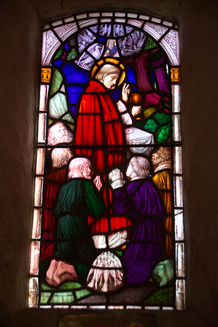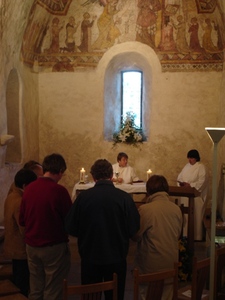
History of the Fishermen's Chapel
On the site of a small 6th Century monastic church, sits the Fishermen's Chapel. Built in the 11th-12th Century, by the Bishop of Coutances. The original timber building with a clay floor was rebuilt in stone, preserving the Christian site.
On the site of a small 6th Century monastic church, sits the Fishermen's Chapel. Built in the 11th-12th Century, by the Bishop of Coutances. The original timber building with a clay floor was rebuilt in stone, preserving the Christian site.

For almost 300 years it remained a single cell building, until the 14th
century, when it was appropriated as a chantry and burial place for a prominent
family. The east wall was decorated with a painting of the Annunciation of the
Virgin Mary, flanked by 14 kneeling figures. With its tiny Norman windows, the
chapel would have been gloomy.
century, when it was appropriated as a chantry and burial place for a prominent
family. The east wall was decorated with a painting of the Annunciation of the
Virgin Mary, flanked by 14 kneeling figures. With its tiny Norman windows, the
chapel would have been gloomy.

Less than 100 years later, another family took over the chantry, refurbishing it to include bigger windows, and lowering the floor.
The chapel became associated with the fishing guilds, to which it owes its current name, in the late medieval periods.
In 1550, during the Acts of Reformation, it was converted into an armoury, housing the parish cannon. So the church remained, until the mid 1800's, when arsenals were provided for the parochial Militia. From this, it became a store room, and a carpentry shop until major restoration in 1883.
The chapel became associated with the fishing guilds, to which it owes its current name, in the late medieval periods.
In 1550, during the Acts of Reformation, it was converted into an armoury, housing the parish cannon. So the church remained, until the mid 1800's, when arsenals were provided for the parochial Militia. From this, it became a store room, and a carpentry shop until major restoration in 1883.

Restoration has continued on this wonderful old building, culminating in 1973
when in conjunction with archaeological studies, the roof was retiled, the
floor paved with granite, and period furniture crafted.
This church has been a centre of Christian worship for 1400 years.
when in conjunction with archaeological studies, the roof was retiled, the
floor paved with granite, and period furniture crafted.
This church has been a centre of Christian worship for 1400 years.